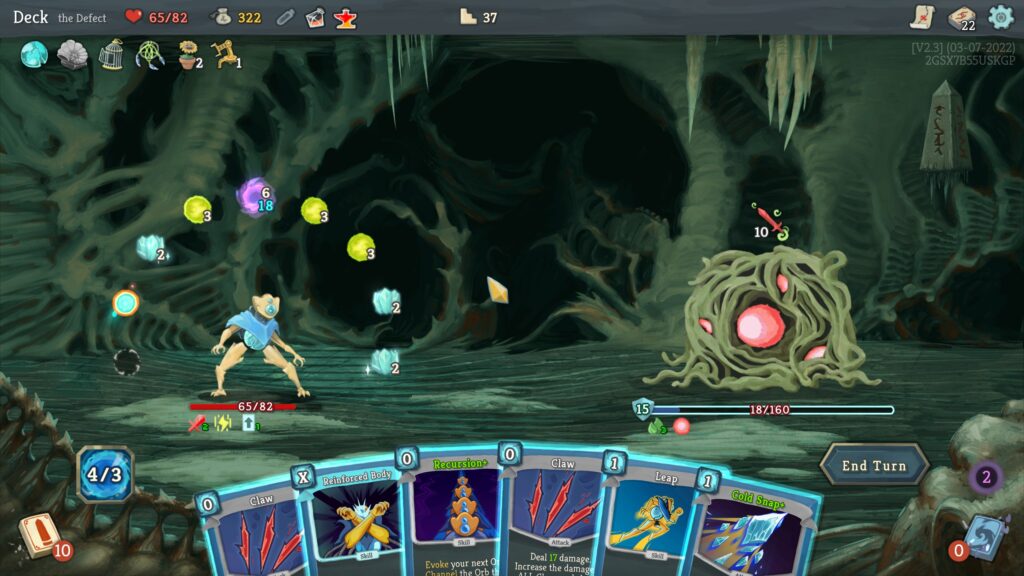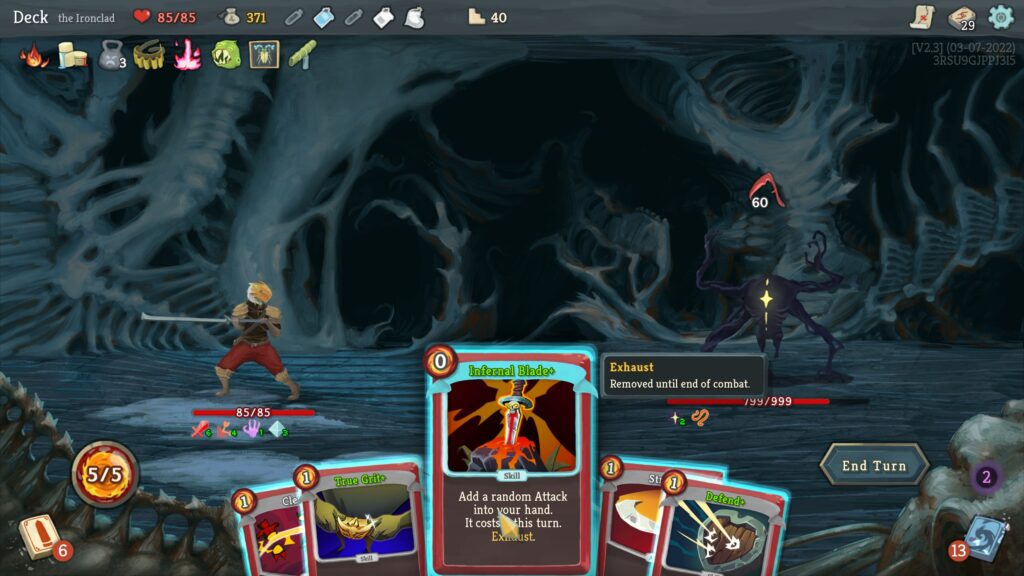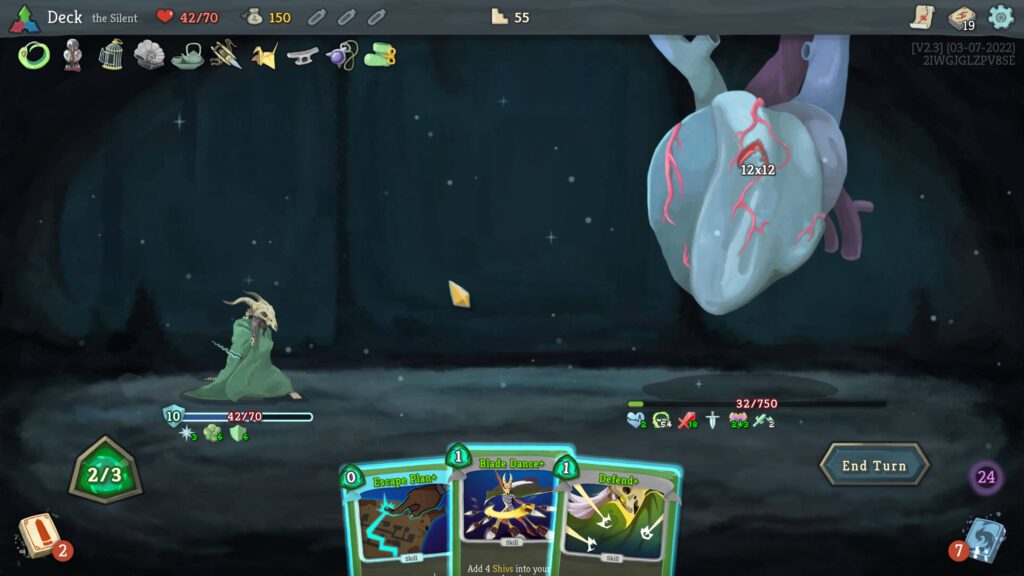
Anyone who knows anything about videogaming doesn’t have to be told how popular this was a while back. It turned out to be highly influential as well as many other games have since copied its simple yet highly addictive design. I never picked it up back then because I hate rogue-likes and the art it uses looked basic to me. But I always knew that I would probably enjoy this somewhat due to my love for deckbuilding mechanics and this is too important of a cultural touchstone to ignore forever. Having put some time into this now, I can say that it really is absolutely brilliant and I was an idiot for putting it off so long.
This is indeed a rogue-like as your character has to fight through a notional dungeon. Notional because it’s just taking a branching path through a series of battles punctuated by resting spots, special events and merchants. You play cards from a hand to attack and defend, paying them with energy that is regenerated each turn. The mechanics are deceptively simple as there isn’t anything like multiple damage and defense types. There is no randomness in damage values either so you can math out turns perfectly and even the randomness of card draws and enemies encountered are all generated in advance. You can’t save-reload, this being a rogue-like, but if you made a mistake during a battle, you can just return to the main menu and resuming the game from there just restarts the battle. Each class starts with its own starter deck of cards but as you win battles you are offered opportunities to draft cards into your deck and removes them as well. Potions can be used to save you when you get into a spot of trouble and relics have the potential to totally change your strategy.

There’s no real story and no explanation for anything beyond some flavor text. You just know that you need to climb the floors and kill the heart at the end. Even the text for story events and the merchant’s quips are rather basic. That works well for me though as I’ve always complained about games trying to convey too much fake history that no one has any interest in. I dislike that the art is simplistic and sometimes looks a little generic, but I do appreciate the creativity in the monster designs. There is just enough art and flavor text to stir your imagination and I love how different monsters can counter specific deck types. I also like that the game is just the right length, with three acts and a short fourth act that must be specially unlocked and can be considered optional. This makes each run short enough that I feel less irritated about having replaying them over and over again.
You start the game with only one of the classes unlocked, the warrior equivalent called the Ironclad with rather straightforward cards and simple to understand mechanics. The game plays well but doesn’t seem like anything special. But as you unlock more classes and cards, see more of the variety of monsters and bosses that can appear and get a feel for the different builds that you can go for for each class, you really start to understand how well designed and balanced this game is. Part of this is surely because it spent a lot of time in Early Access and player feedback helped refine the design so I’m just now playing the final polished version. But it’s undeniably brilliant how rich the design space for possible strategies are. You can delve deep into the debates and discussions about the merits of each card, how to plan to beat particular bosses, and so on and not come up for air for hours. As a new player, beating the end bosses on normal may seem daunting but players have proved, again and again, that it is possible to beat the heart at the highesr ascension, or difficulty level, once you understand the game space enough.

While there is some skill involved in playing the cards during battles, particularly when playing a more complex class like the Watcher, for the most part success is determined by the cards and items you bring into the fight. This means that while there is not much randomization during the fights themselves, chance does play a big role in what cards you get offered over the course of a run and which relics you get. Of course, experienced players can make educated guesses about which cards they are likely to get, know which enemies are coming up and make a deck that consistently wins games this way. But it’s still frustrating for example to be in the middle of constructing a Wrath-based deck as the Watcher and then a transform effect gives you three cards that use a Divinity-based strategy instead. In one particular run, I got four copies of the card Like Water which gives you free defense every turn you spend in the Calm stance. That run was a total cakewalk right up to the Corrupted Heart in Act 4.
A single relic can totally change how any particular run plays. The controversial Snecko Eye for example lets you draw more cards every turn but also totally randomizes their costs. It’s a very powerful effect but can also ruin many decks. You never know exactly what you will get and rarer cards are much more powerful than common ones in this game. This though is also what makes the game so addictive. You can’t dream up an ideal deck and just go to town. Instead, you’re always looking forward to next card or relic reward and thinking about how each choice shapes your deck going forwards. Having some idea of what you may face soon, you may need to compromise your long-term plan just to survive the next fight. The fact that your health is also a conserved resource means that every point counts. It’s not enough to win fights, it matters to win them while spending as little health as possible.

Naturally even killing the heart at the end of Act 4 isn’t the end of the game as you just unlock higher difficulty levels, called ascensions, to do it all over again. This is where I got out though as I don’t usually NG+ or equivalent modes in games. I will note that Ascension 1 is interesting at it simply spawns more elites to fight. Since these enemies offer better rewards when defeated, it actually makes your deck stronger. Of the four classes, I dislike the Defect the most as so many of the abilities target random enemies and the math is hard to figure out. The Watcher is so hilariously overpowered in having tons of good cards that pretty all work together. The Silent is fun too as you get to play lots and lots of cards but woe betide you if you meet the Time Eater boss who imposes a hard limit on the number of cards you can play. The Ironclad is a little too simple for me and particularly repetitive at the beginning whenever you start a new run. I keep trying to make exhaust-based decks with this class but it never works but constructing an insurmountable defense with him is easy.
Suffice to say that this game really won me over despite my initial skepticism and dislike of how it looks. It’s astonishing how far the designers could stretch such simple and easy to understand mechanics. The game’s balance is so finely tuned too. Of course some cards are way more powerful than others, and some relics are so good they can entirely define a run. But due to the semi-random rogue-like nature of a run, that’s fine. The difficulty may seem daunting at first but as far as I tell, every run is beatable at least at low ascensions if you know the cards and the enemies well enough. It is so much fun when you manage to pull off some ridiculous infinite combo. But there are also times for me when the first few card and relic picks are so mediocre that I just abandon the run. I’m still not crazy enough to want to spend hundreds of hours trying to achieve Ascension 20 with every character but I did put plenty of time into this and loved every moment of it.
One thought on “Slay the Spire”